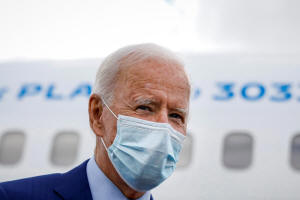Reuters/Ipsos poll shows Biden leading in Pennsylvania, Wisconsin
 Send a link to a friend
Send a link to a friend
 [October 06, 2020]
By Jason Lange [October 06, 2020]
By Jason Lange
WASHINGTON (Reuters) - Democratic
presidential candidate Joe Biden appeared to lead President Donald Trump
in Wisconsin and Pennsylvania less than a month before the Nov. 3
election, according to Reuters/Ipsos opinion polls released on Monday.
The polls showed the former vice president ahead by 5 percentage points
in Pennsylvania, matching the poll's credibility interval. Biden led
Trump by 6 points in Wisconsin. In both states, Biden improved his
position relative to mid-September.
Reuters/Ipsos is polling likely voters in six states - Wisconsin,
Pennsylvania, Michigan, North Carolina, Florida and Arizona - that will
play critical roles in deciding whether Trump wins a second term in
office or if Biden ousts him in the November election.
Below is a state-by-state look at Reuters/Ipsos findings, based on the
online responses of likely voters, which include responses from some who
cast ballots ahead of the formal Nov. 3 Election Day, which is
increasingly common due to the coronavirus pandemic:
WISCONSIN (Sept. 29-Oct. 5):
* Voting for Biden: 50%
* Voting for Trump: 44%
* 50% said Biden would be better at handling the coronavirus pandemic.
41% said Trump would be better.
* 51% said Trump would be better at managing the economy. 44% said Biden
would be better.
* 13% said they already had voted.

PENNSYLVANIA (Sept. 29-Oct. 5):
* Voting for Biden: 50%
* Voting for Trump: 45%
* 51% said Biden would be better at handling the coronavirus pandemic.
41% said Trump would be better.
* 51% said Trump would be better at managing the economy. 46% said Biden
would be better.
* 2% said they already had voted.
FLORIDA (Sept. 11-16):
* Voting for Biden: 47%
* Voting for Trump: 47%
* 46% said Biden would be better at handling the coronavirus pandemic.
46% said Trump would be better.
* 51% said Trump would be better at managing the economy. 41% said Biden
would be better.
* 3% said they already had voted.
ARIZONA (Sept. 11-17):
* Voting for Biden: 47%
* Voting for Trump: 46%
* 47% said Biden would be better at handling the coronavirus pandemic.
44% said Trump would be better.
* 49% said Trump would be better at managing the economy. 44% said Biden
would be better.
* 3% said they already had voted.
[to top of second column]

|

Democratic presidential candidate Joe Biden speaks to the press pool
before he boards his campaign plane to travel to Miami at New Castle
Airport in New Castle, Delaware, U.S., October 5, 2020.
REUTERS/Brendan McDermid

MICHIGAN (Sept. 11-16):
* Voting for Biden: 49%
* Voting for Trump: 44%
* 50% said Biden would be better at handling the coronavirus
pandemic. 44% said Trump would be better.
* 48% said Trump would be better at managing the economy. 45% said
Biden would be better.
* 2% said they already had voted.
NORTH CAROLINA (Sept. 11-16):
* Voting for Biden: 47%
* Voting for Trump: 47%
* 47% said Biden would be better at handling the coronavirus
pandemic. 45% said Trump would be better.
* 51% said Trump would be better at managing the economy. 44% said
Biden would be better.
* 4% said they already had voted.
NOTES
The Reuters/Ipsos opinion polls are conducted online in all six
states in English, as well as in Spanish in Arizona and Florida.
* In Wisconsin, from Sept. 29 to Oct. 5, it gathered responses from
1,000 adults, including 601 likely voters, and had a credibility
interval of 5 percentage points.
* In Pennsylvania, from Sept. 29 to Oct. 5, it gathered responses
from 1,000 adults, including 605 likely voters, and had a
credibility interval of 5 percentage points.
* In Florida, from Sept. 11 to 16, it gathered responses from 1,005
adults, including 586 likely voters, and had a credibility interval
of 5 percentage points.
* In Arizona, from Sept. 11 to 17, it gathered responses from 1,005
adults, including 565 likely voters, and had a credibility interval
of 5 percentage points.

* In Michigan, from Sept. 11 to 16, it gathered responses from 1,005
adults, including 637 likely voters, and had a credibility interval
of 4 percentage points.
* In North Carolina, from Sept. 11 to 16, it gathered responses from
1,005 adults, including 586 likely voters, and had a credibility
interval of 5 percentage points.
(Reporting by Jason Lange in Washington and Chris Kahn in New York;
Editing by Scott Malone and Peter Cooney)
[© 2020 Thomson Reuters. All rights
reserved.] Copyright 2020 Reuters. All rights reserved. This material may not be published,
broadcast, rewritten or redistributed.
Thompson Reuters is solely responsible for this content. |